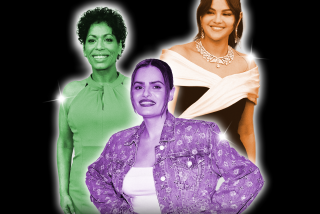How to get on TV: Let the audience do the convincing
Greg BRAXTONâs article about the two Latino actresses who were signed to talent deals by CBS but didnât land roles in any fall series (âStill Looking,â May 21) points out the inherent problems minorities face in breaking into television but lacks an explanation of the causal factors. The hurdles are many, such as the way the industry runs on cronyism, and the fact that access to TV airwaves is limited.
Against these and so many other obstacles, an NAACP-led coalition of advocacy groups has been lobbying over the last five years for greater representation of African Americans, Latinos, Asian/Pacific Islanders and Native Americans.
In this light, the four major networksâ various talent showcases and outreach programs for minorities can be seen as a bone they are tossing to their critics. But is there meat on that bone? Not judging by the results. In studies released over the last seven months by the NAACP, the Multi-Ethnic Coalition and Children Now, ABC, CBS, NBC and Fox have been faulted for not making more progress in employing minority actors in prime time. While some improvement was noted with regard to African Americans and Latinos, there has been none for Asian/Pacific Islanders and Native Americans.
âThe message prime-time TV sends to kids about the world in which they live is that some racial groups are privileged, while others are underrepresented or even invisible,â Patti Miller, director of Children Nowâs Children & the Media program, concluded in April. âRegrettably, the networks have not done nearly enough in the past five years to change this skewed picture.â
This doesnât mean that television is impossible to influence, but it must come from outside market forces exerting their pressure. For instance, 30 years ago, when the early hip-hop DJs were vying for mainstream distribution, they were scorned by the powers that be, who didnât get it. So instead of complaining and protesting for the industry to let them in, the DJs took control of the situation in the only way that makes sense: They became entrepreneurial. By selling their cassettes (mixtapes) at the street level, they confirmed audience demand and woke up the staid music industry.
Similarly, when Nia Vardalos staged âMy Big Fat Greek Weddingâ as a small play, she was being entrepreneurial. In doing so, she conserved energy that would have been expended playing the Hollywood development lottery and redirected it toward a productive strategy. That led to her movie deal, and, lo and behold, that success was parlayed into a TV deal.
In each case, artists connected to and leveraged their audiences.
Lourdes Colon, one of the actresses in Braxtonâs story, may feel that âitâs getting betterâ as a result of going through the audition cattle calls, but that is an individual, anecdotal perspective that is contradicted by the statistics about minority employment in Hollywood. Worse, such statements obfuscate the harsh realities of why television is so impenetrable for minorities via outreach programs or other traditional means.
The NAACP-led coalition would be better off developing entrepreneurial projects for their constituents to connect to their audiences rather than wasting time and energy lobbying a business that for the most part only responds to market pressures.
More to Read
The complete guide to home viewing
Get Screen Gab for everything about the TV shows and streaming movies everyoneâs talking about.
You may occasionally receive promotional content from the Los Angeles Times.






